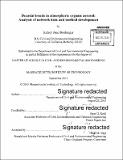Decadal trends in atmospheric organic aerosol :
Author(s)
Boulanger, Kelsey Jane
DownloadFull printable version (9.495Mb)
Other Contributors
Massachusetts Institute of Technology. Department of Civil and Environmental Engineering.
Advisor
Jesse H. Kroll.
Terms of use
Metadata
Show full item recordAbstract
Organic aerosol (OA) makes up a substantial fraction of atmospheric particulate matter, yet its sources and controlling factors - and thus its impacts on climate and human health - are not well understood. Recently-developed analytical techniques have provided new insight into OA chemistry, but major uncertainty remains in how OA has changed over the past few decades. Characterizing long-term trends in OA would allow for better calibration of models that currently struggle to replicate ambient organic measurements as well as answer questions of how changes in OA relate to changes in emissions sources, anthropogenic-biogenic emissions interactions, altered chemistry, and more. This work represents a two-fold effort to better constrain our understanding of OA trends spatially, temporally, and chemically. First, trends in aerosol species concentrations over the past two decades are examined using existing data from the U.S. Interagency Monitoring of Protected Visual Environments (IMPROVE) network to provide insight into the long-term OA evolution across the rural U.S. Along with large decreases in total aerosol amounts (30-50%), OA is found to decrease at a fractional rate nearly equivalent to the decreases in three other major aerosol species: nitrate, sulfate, and elemental carbon. This suggests a link between the controlling factors of the different species, but explaining these observations is made challenging by the lack of chemical characterization of historic OA measurements that would help point to changing sources and chemistry. Thus, the second part of this work introduces a technique that enhances our ability to obtain important chemical information from small-volume environmental aerosol samples, such as filter extracts from remote regions like those monitored by the IMPROVE network, that were previously excluded from Aerodyne aerosol mass spectrometer (AMS) analysis due to the prohibitive volumes required for standard atomization. The Small Volume Nebulizer (SVN) nebulizes microlitersized liquid samples, allowing for highly time- and mass-resolved chemical analysis of dissolved organic species on the AMS and providing valuable insight into the factors that control observed OA trends. By examining historic trends in particulate matter loading and composition, and expanding AMS coverage to include small-volume environmental samples, we can begin to answer the question of how and why OA has changed over the past few decades - and what that means for OA chemistry, the climate, and regional and global air quality.
Description
Thesis: S.M., Massachusetts Institute of Technology, Department of Civil and Environmental Engineering, 2015. Cataloged from PDF version of thesis. Includes bibliographical references (pages 63-67).
Date issued
2015Department
Massachusetts Institute of Technology. Department of Civil and Environmental EngineeringPublisher
Massachusetts Institute of Technology
Keywords
Civil and Environmental Engineering.